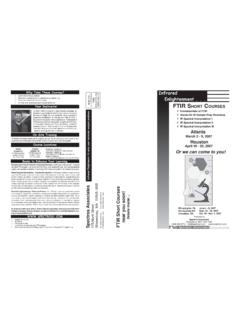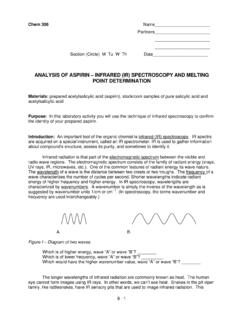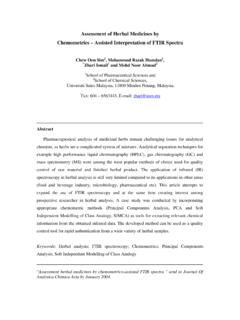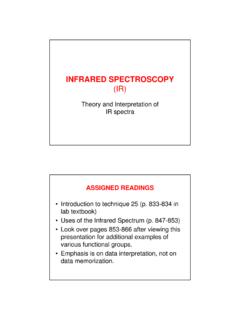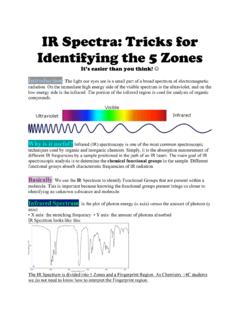Transcription of Infrared Polymer Analysis - Infrared Enlightenment
1 Spectros Associates Proudly Presents the Short Course Infrared Polymer Analysis Instructor: Dr. Brian C. Smith This 3-day training course is a broad overview how to use FTIR to analyze polymeric samples. On Day 1 we cover how an FTIR works, how to measure data and instrument quality, analyzing mixtures, and how to use ATR (Attenuated Total Reflectance) to analyze polymers, powders, and liquids. Days 2 and 3 are about Infrared Spectral interpretation . You will learn how to interpret an Infrared spectrum to determine unknown molecular structures and to perform identities properly. The course introduces a systematic, 10-step approach to Infrared interpretation .
2 Then, the diagnostic Infrared bands of many economically important molecules, including polymers, are presented. Attendees interpret many unknown spectra in class with the help of the instructor. Each attendee will receive two books, Fundamentals of FTIR, a 220 page introduction to instrumentation and sample preparation, and Infrared Spectral interpretation , a complete 260 page guide to interpreting Infrared data. Both books were written by Dr. Smith, and are published by CRC Press. Day 1 Fundamentals of FTIR I. The Basics of FTIR A. Introduction to Infrared Spectroscopy 1.
3 The Properties of Light 2. What is an Infrared Spectrum? 3. Infrared Spectroscopy: Good and Bad Points B. The Advantages of FT-IR 1. Signal-to-Noise Ratio (SNR) 2. The Throughput Advantage 3. The Multiplex Advantage C. The Disadvantage of FTIR: Water and CO2 Peaks II. How an FT-IR Works A. Interferometers & Interferograms B. How a Spectrum is Produced 1. The Fourier Transform 2. Background & Single Beam Spectra C. Optimizing Resolution & Minimizing Noise D. FTIR Hardware 1. Infrared Sources 2. Beamsplitters 3.
4 Detectors: DTGS and MCT 4. The He-Ne Laser E. Measuring Spectral & Instrument Quality III. Spectral Manipulations: Learn More From Your Spectra A. The Laws of Spectral Manipulation B. Spectral Subtraction: Simplifying Mixture Spectra 1. Theory 2. Optimizing Subtraction Results 3. Spotting Artifacts C. Library Searching 1. Background & Theory 2. The Search Process 3. Properly Interpreting Search Results 4. Subtract & Search Again: The Analysis of Mixtures IV. Transmission Sampling Techniques for Polymers A.
5 KBr Pellets 1. Sample Preparation 2. Pellet Pitfalls B. Cast Films C. The Heat and Pressure Method V. Attenuated Total Reflectance (ATR): A Sampling Technique for Many Samples A. Accessory Design B. Variables Affecting Spectral Appearance C. Applications 1. Polymers 2. Semi-Solids: Gels, Waxes, Pastes etc. 3. Liquids 4. Powders Day 2 I.
6 The Fundamentals of Infrared interpretation A. The Properties of Light B. The Meaning of Peak Positions, Heights, and Widths C. A Systematic Approach to Spectral interpretation 1. Dealing with Mixtures 2. Performing Identities Properly 3. A Systematic 10-Step Approach to Infrared interpretation II. Infrared Spectra of Hydrocarbons A. Alkanes: C-H Stretching and Bending Vibrations 1. Straight Chain Alkanes 2. Estimating Hydrocarbon Chain Length 3. Branched Alkanes B. Alkenes 1.
7 Substitution Patterns 2. Distinguishing Cis/Trans Isomers C. Aromatic Hydrocarbons 1. Mono-Substituted Benzene Rings 2. Distinguishing Ortho, Meta, and Para Isomers III. Alcohols & Phenols A. Differentiating Primary, Secondary, and Tertiary Alcohols B. Phenols C. Distinguishing Alcohols from Water IV. Ethers A. Saturated Ethers B. Aromatic Ethers C. The Methoxy Group Day 3 I. The Carbonyl (C=O) Functional Group A. Intro. to Carbonyl Spectra B. Ketones C. Carboxylic Acids D Carboxylates (Soaps) E Esters: The Rule of 3 F Summary II.
8 Organic Nitrogen Compounds A. Amides 1. Structure, Nomenclature, and Bonding 2. Primary Amides 3. Secondary Amides B. Amines 1. Distinguishing the Three Types of Amines 2. Methyl Groups Bonded to Nitrogen D. Nitriles III. Introduction to the Infrared Spectra of Polymers A. Low and High Density Polyethylene B. Polypropylene C.
9 Polystyrene D. Polyethylene Terephthalate (PET) IV. Spectra of Polymers with Complex Structures A. Nylons B. Acrylates C. Teflon D. Rubbers Rev. 1/04
